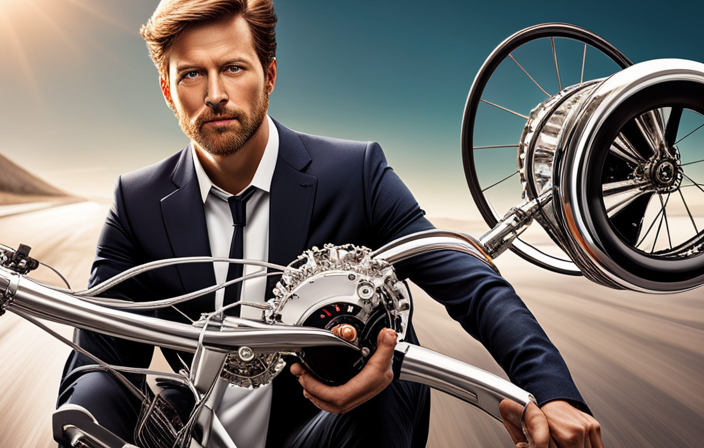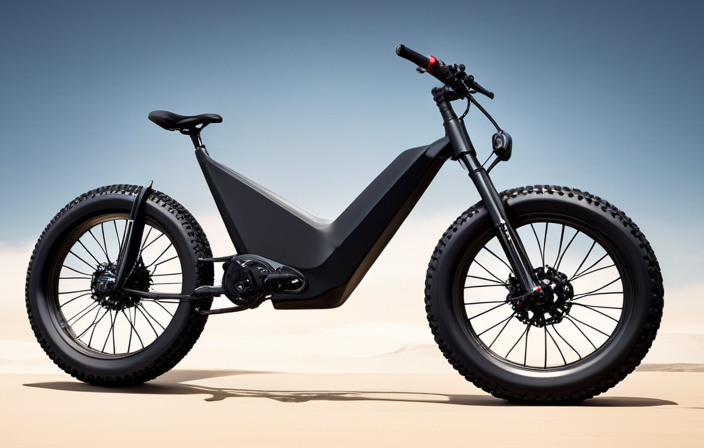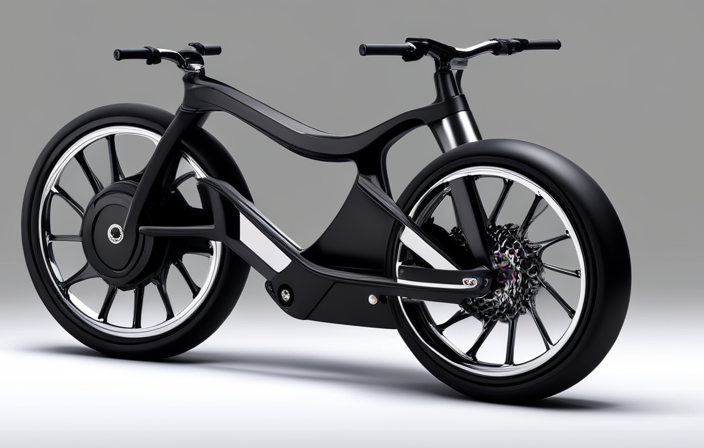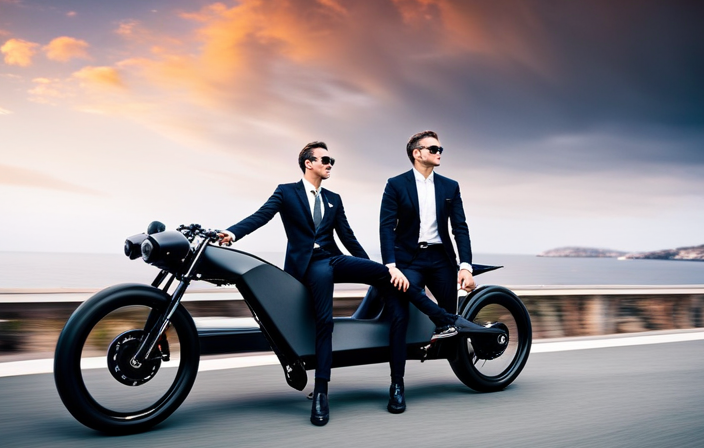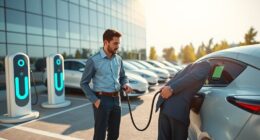Did you know that electric bike engines can provide up to 50% more power and speed than traditional bikes?
In this article, I will delve into the fascinating world of electric bike engines, explaining how they work and the various components involved.
From the role of the battery in powering the bike to the different types of motors used, we will explore the intricate details of these engines.
So, let’s dive in and uncover the inner workings of electric bike engines together.
Key Takeaways
- Electric bike engines convert electrical energy into mechanical power.
- Precise power control enhances the riding experience.
- The engines provide an extra power boost when pedaling.
- Overheat protection and short-circuit prevention ensure safe and reliable operation.
Understanding the Basics of Electric Bike Engines
To understand the basics of electric bike engines, you’ll need to know how they work. Electric bike engine technology has come a long way in recent years, and it holds great promise for the future of electric bike engines.
These engines are typically powered by a motor that is connected to the bike’s drivetrain. When you pedal, the motor kicks in and provides additional power to assist your pedaling. This allows you to ride faster and tackle hills more easily. The motor is controlled by an electronic system that monitors your pedaling speed and adjusts the assistance accordingly. It’s a seamless integration of human power and electric power, making for a smooth and efficient ride.
Moving on to the role of the battery in powering an electric bike, it plays a vital role in providing the electricity needed to drive the motor.
The Role of the Battery in Powering an Electric Bike
You can’t underestimate the importance of the battery when it comes to powering an e-bike. It is the heart of the system, providing the necessary energy to propel the bike forward. The battery’s charging process is crucial for ensuring that it is always ready to power your rides. It is typically done by connecting the battery to a charger, which replenishes its energy levels.
However, it is important to note that the battery lifespan can be affected by factors such as temperature, depth of discharge, and the number of charge cycles it goes through. Taking proper care of your battery, such as avoiding extreme temperatures and not fully discharging it, can help prolong its lifespan. Understanding the battery’s role and how to maintain it is essential for maximizing your e-bike’s performance.
Now, let’s transition into exploring the different types of electric bike motors.
Exploring the Different Types of Electric Bike Motors
The different types of electric bike motors can greatly impact the performance and riding experience. When comparing the various types, it is important to consider their advantages.
One type is the hub motor, which is located in the center of the wheel. It provides a smooth and quiet ride, but can make the bike feel heavier.
Another type is the mid-drive motor, which is positioned near the crankset. This type offers better weight distribution and a more natural riding feel. However, it can be more expensive and require more maintenance.
Lastly, there are the friction drive motors, which are attached to the side of the wheel. These motors are lightweight and simple to install, but they can wear out the tire quickly.
Understanding these different motor types is crucial in understanding how the motor converts electric energy into mechanical power.
How the Motor Converts Electric Energy into Mechanical Power
When comparing the different types of electric bike motors, it’s important to understand how they convert electric energy into mechanical power. Electric bike motor efficiency plays a crucial role in determining the performance and range of an electric bike.
The efficiency of an electric bike engine refers to how effectively it converts electrical energy into mechanical power. Higher efficiency means less energy is wasted as heat and more is used to propel the bike forward. This results in longer battery life and better overall performance.
The advantages of electric bike engines are clear: they offer a cleaner and more sustainable mode of transportation, with lower operating costs compared to traditional gasoline engines.
Now, let’s delve into the importance of torque in electric bike performance.
The Importance of Torque in Electric Bike Performance
To fully understand the importance of torque in electric bike performance, it’s crucial to consider its role in accelerating the bike. Torque is the force that causes an object to rotate around an axis, and in the context of electric bikes, it directly impacts the acceleration.
Here are some reasons why torque is vital for electric bike performance:
- Increased torque provides faster acceleration, allowing for quicker and more efficient rides.
- Higher torque enables the bike to climb steep hills effortlessly, enhancing overall performance.
- Torque contributes to improved handling and maneuverability, giving riders a sense of control and confidence.
- Optimal torque ensures a smooth and responsive ride, enhancing the overall riding experience.
Understanding the importance of torque in electric bike performance leads us to the next topic: regenerative braking and how electric bikes generate power.
Regenerative Braking: How Electric Bikes Generate Power
Understanding regenerative braking and how it generates power is essential for getting the most out of your electric bike. Regenerative braking is a mechanism that converts the kinetic energy produced during braking into electrical energy, which is then stored in the battery for later use. This process improves regenerative braking efficiency and helps extend the battery life of your electric bike.
To illustrate the impact of regenerative braking on battery life, consider the following table:
| Traditional Braking | Regenerative Braking | |
|---|---|---|
| Energy wasted as heat | Energy converted and stored in battery | |
| Decreases battery life | Increases battery life | |
| Less efficient | More efficient |
As you can see, regenerative braking not only helps conserve energy that would otherwise be wasted, but it also improves the overall efficiency of your electric bike. This means that you can ride longer distances without having to worry about running out of battery power.
Now let’s dive into the next section and explore the role of the controller in controlling speed and power output.
The Role of the Controller in Controlling Speed and Power Output
If you want to control the speed and power output of your electric bike, the controller plays a crucial role. The controller serves as the brain of the electric bike, responsible for power management and speed regulation. Here are some key aspects of the controller’s role:
- Voltage regulation: The controller ensures that the right amount of voltage is supplied to the motor, allowing for optimal power output.
- Current control: By regulating the current flowing to the motor, the controller manages the amount of power delivered, preventing overload or excessive energy consumption.
- Speed adjustment: The controller enables riders to adjust the speed of their electric bike, offering different levels of assistance based on their preferences.
- Acceleration management: With precise control over the power output, the controller allows for smooth and controlled acceleration, enhancing the overall riding experience.
- Safety features: The controller incorporates safety features such as overheat protection and short-circuit prevention, ensuring the reliable and safe operation of the electric bike.
By effectively managing power and speed, the controller provides riders with a customizable and efficient riding experience.
Now, let’s explore how electric bike engines provide assistance to riders.
How Electric Bike Engines Provide Assistance to Riders
Electric bike engines assist riders by providing an extra boost of power when pedaling. These engines are designed to be efficient, ensuring that the energy consumed is maximized for optimal performance. They utilize advanced technology to convert electrical energy into mechanical power, resulting in a smooth and seamless riding experience.
The efficiency of electric bike engines is crucial not only for enhancing the overall performance but also for minimizing environmental impact. By reducing the reliance on fossil fuels, these engines help to reduce air pollution and carbon emissions. This makes electric bikes a more sustainable transportation option, contributing to a healthier and cleaner environment.
Furthermore, the use of electric bike engines promotes a greener lifestyle, encouraging individuals to adopt eco-friendly means of commuting. Transitioning into the subsequent section, the benefits of using an electric bike engine are numerous and diverse.
The Benefits of Using an Electric Bike Engine
To fully enjoy the benefits of using an electric bike engine, you’ll be amazed at how effortlessly you can conquer steep hills and long distances. The efficiency of electric bike engines is truly remarkable. Here are three reasons why:
-
Increased Range: Electric bike engines allow you to travel longer distances without getting exhausted. With the assistance of the motor, you can easily cover more ground and explore new areas.
-
Hill Climbing Power: Electric bike engines provide a significant boost when tackling steep inclines. You won’t need to strain your muscles or struggle to maintain momentum. The motor effortlessly propels you uphill, making cycling a breeze.
-
Reduced Environmental Impact: Electric bike engines are eco-friendly alternatives to traditional gas-powered engines. They produce zero emissions and contribute to a cleaner, greener environment.
By harnessing the power of an electric bike engine, you can enjoy efficient rides, conquer challenging terrain, and contribute to a healthier planet.
Now, let’s delve into some maintenance and care tips for electric bike engines.
Maintenance and Care Tips for Electric Bike Engines
Proper maintenance and care are essential for keeping your electric bike engine running smoothly. As an electric bike owner, it is important to familiarize yourself with troubleshooting tips to address common issues that may arise.
One common problem is a loss of power. If you experience this, check the battery first to ensure it is properly charged. If the battery is fine, examine the connections between the battery and motor to make sure they are secure.
Another common issue is a noisy motor. This can be caused by loose bolts or a damaged motor. Tighten any loose bolts and inspect the motor for any signs of damage. In some cases, a noisy motor may require professional assistance for repair or replacement.
Frequently Asked Questions
How much does an electric bike engine weigh?
An electric bike engine typically weighs around 2-4 kilograms, depending on the model. The lightweight design enhances electric bike engine efficiency, allowing for better acceleration, longer battery life, and improved handling.
Can I use an electric bike engine in rainy or snowy conditions?
Yes, you can use an electric bike engine in rainy or snowy conditions. While waterproofing is important, regular maintenance is key. Protect the engine with a waterproof cover, seal any exposed areas, and clean it thoroughly after each ride to prevent damage and ensure optimal performance.
How long does it take to charge an electric bike engine battery?
It takes around 3-6 hours to fully charge an electric bike engine battery, depending on its capacity. The charging time may vary, but it is crucial to follow the manufacturer’s instructions for optimal battery performance and longevity.
Is it possible to upgrade or replace the motor in an electric bike engine?
Upgrading the motor power in an electric bike engine is possible, allowing for increased performance. Additionally, advancements in battery technology make it feasible to replace the battery for improved range and efficiency.
Are there any legal restrictions or requirements for using an electric bike engine on public roads?
Yes, there are legal restrictions and requirements for using an electric bike engine on public roads. It is important to adhere to these regulations to ensure the legality and address safety concerns associated with electric bike engines.
Conclusion
In conclusion, electric bike engines are fascinating pieces of technology. They rely on a battery to provide power, which is then converted into mechanical power by the motor. The torque produced by the motor is crucial for the bike’s performance. The controller plays a vital role in controlling the speed and power output.
These engines provide assistance to riders, making cycling easier and more enjoyable. With numerous benefits, such as eco-friendliness and cost-effectiveness, electric bike engines are a great choice for transportation. Just remember to maintain and care for your engine to ensure its longevity.
As they say, a well-oiled machine is a joy to ride.
